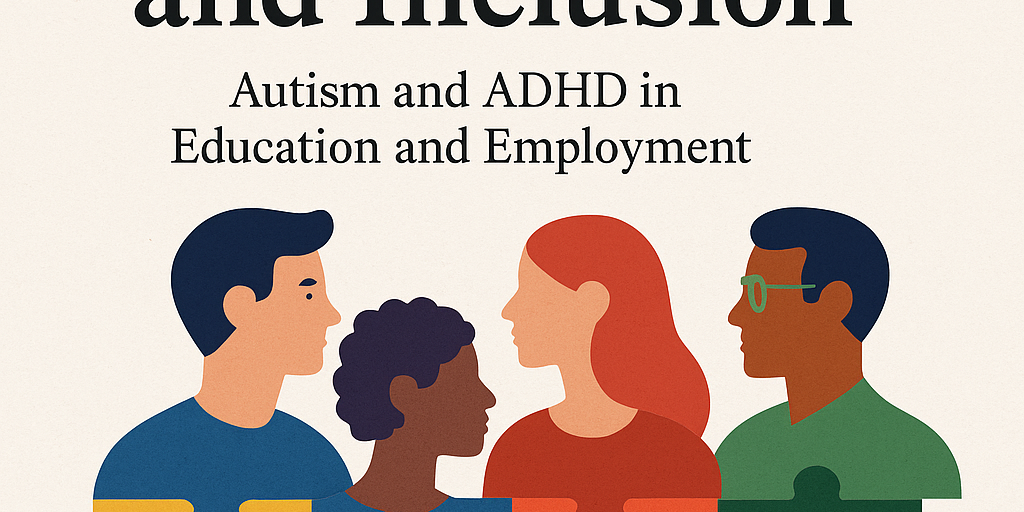Abstract: This paper explores the concept of neurodiversity within a psychological framework, focusing on the unique challenges faced by individuals with Autism Spectrum Disorder (ASD) and Attention-Deficit/Hyperactivity Disorder (ADHD) in educational and occupational environments. Drawing from recent empirical studies and theoretical models, it emphasizes the importance of inclusive policies, effective psychological support strategies, and intervention models. The study advocates for the recognition of neurodiverse traits as natural variations of human cognition, arguing for a shift from pathologization to acceptance. The role of psychologists in facilitating social integration and reducing stigma is critically examined.
Keywords: Neurodiversity, Autism, ADHD, Inclusion, Psychological Support, Education, Workplace
1. Introduction The term “neurodiversity” refers to the idea that neurological differences such as autism, ADHD, dyslexia, and others are part of normal human variation and should not be viewed solely through a pathological lens (Singer, 1999). This paradigm challenges traditional deficit-based models and instead promotes a strengths-based approach. Despite growing awareness, individuals with ASD and ADHD continue to face exclusion, discrimination, and inadequate support in both educational and workplace settings (Armstrong, 2010). This paper examines these challenges from a psychological standpoint and proposes evidence-based strategies to promote meaningful inclusion.
2. Theoretical Foundations of Neurodiversity in Psychology Neurodiversity aligns with key tenets of positive psychology (Seligman & Csikszentmihalyi, 2000) and client-centered therapy (Rogers, 1951), which emphasize the inherent value and potential of each individual. Psychologically, neurodiverse individuals often exhibit unique cognitive profiles, emotional regulation patterns, and social processing mechanisms that may not align with neurotypical norms. Emerging models advocate for interventions that leverage individual strengths while accommodating specific challenges. These models emphasize resilience, adaptive functioning, and personalized goal setting.
3. Autism Spectrum Disorder in Education: Inclusive Practices Students with ASD are characterized by difficulties in social communication, restricted interests, and repetitive behaviors (APA, 2013). In educational settings, these students often face social isolation, bullying, and a lack of appropriate instructional strategies. Research highlights the effectiveness of individualized education plans (IEPs), sensory-sensitive classrooms, and social communication training in improving academic and social outcomes (Koenig et al., 2010). Teacher training and peer education are also critical for fostering an inclusive learning environment.
4. ADHD and Workplace Adaptation ADHD is marked by symptoms of inattention, impulsivity, and hyperactivity, which can impair functioning in structured environments like workplaces. Employees with ADHD may struggle with time management, task prioritization, and interpersonal communication. However, many also possess strengths such as creativity, high energy, and problem-solving skills under pressure (Barkley, 2015). Workplace accommodations, executive functioning coaching, and psychoeducational interventions can significantly enhance job performance and satisfaction. Inclusive employment policies and mentorship programs further support the integration of ADHD individuals.
5. Psychological Interventions and Inclusive Models Effective inclusion requires a multidimensional approach incorporating psychological, organizational, and policy-level interventions:
- Cognitive Behavioral Therapy (CBT): Proven effective for ADHD in enhancing time management, emotional regulation, and impulse control.
- Social Skills Training: Helps individuals with ASD develop competencies in interpreting social cues, initiating conversations, and building relationships.
- Psychoeducation: Increases awareness among educators, employers, and families regarding neurodiversity and necessary accommodations.
- Peer Support and Mentoring: Facilitates community belonging and enhances self-efficacy.
- Universal Design for Learning (UDL): An educational framework that promotes flexible learning environments accommodating all learners.
6. Legal Frameworks and Policy Implications Legislation in several countries mandates support for neurodiverse individuals. For instance, in the United States, the Individuals with Disabilities Education Act (IDEA) and the Americans with Disabilities Act (ADA) provide a legal basis for inclusive practices in schools and workplaces. In Turkey, the Ministry of National Education’s Special Education Services Regulation (2023) outlines provisions for supporting students with disabilities. Nonetheless, implementation gaps persist due to insufficient resources, limited professional training, and societal stigma.
7. Societal Perceptions and Media Representation Media portrayals often reinforce stereotypes by depicting neurodiverse individuals as either savants or incapable. Balanced and authentic representations are essential to challenging public misconceptions and promoting understanding. Psychologists can play a vital role in shaping these narratives through advocacy, media literacy programs, and collaboration with content creators.
8. Future Directions for Research and Practice Future research should explore:
- Long-term effects of inclusive education programs on academic and social outcomes.
- Effectiveness of employer-based training in supporting neurodiverse workers.
- Intersectionality and cultural influences on neurodiverse experiences.
- Technological innovations such as AI-driven learning platforms, digital therapeutic tools, and virtual reality-based social skills training. Collaboration between researchers, clinicians, educators, and policy makers is crucial for advancing inclusive psychology.
9. Conclusion Neurodiversity represents not only a shift in understanding cognitive and behavioral differences but also an ethical commitment to social justice and inclusion. Psychologists have a central role in developing, implementing, and evaluating inclusive practices that empower neurodiverse individuals. Achieving true inclusion requires systemic change, interdisciplinary cooperation, and continued advocacy.
References
- American Psychiatric Association. (2013). Diagnostic and Statistical Manual of Mental Disorders (5th ed.).
- Armstrong, T. (2010). Neurodiversity: Discovering the Extraordinary Gifts of Autism, ADHD, Dyslexia, and Other Brain Differences. Da Capo Lifelong Books.
- Barkley, R. A. (2015). Attention-Deficit Hyperactivity Disorder: A Handbook for Diagnosis and Treatment (4th ed.). The Guilford Press.
- Koenig, K. et al. (2010). Social Skills Interventions for Youth with Autism Spectrum Disorders. Education and Treatment of Children, 33(4), 395–419.
- Ministry of National Education (MEB), Turkey. (2023). Special Education Services Regulation.
- Rogers, C. R. (1951). Client-Centered Therapy: Its Current Practice, Implications and Theory. Houghton Mifflin.
- Seligman, M. E. P., & Csikszentmihalyi, M. (2000). Positive Psychology: An Introduction. American Psychologist, 55(1), 5–14.
- Singer, J. (1999). Why Can’t You Be Normal for Once in Your Life? From a Problem with No Name to the Emergence of a New Category of Difference. In M. Corker & S. French (Eds.), Disability Discourse. Open University Press.






